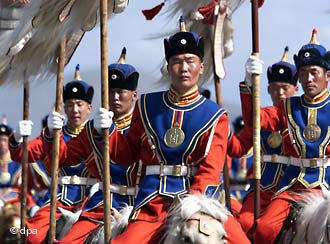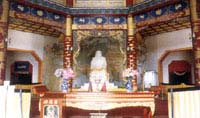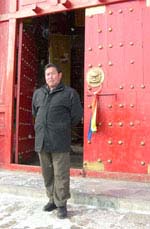|
2005.02.17
By: RFA, Gardi Borjigin
 |
|
|
Mongolian state horsemen, riding seven white steeds and
bearing traditional banners from the time of Gengis Khan,
head to the annual Naadam Festival near Ulaan Bator, July
2000, Photo: AFP/Stephen Shaver
|
|
ORDOS,
Inner Mongolia—Thousands of Mongolians turned up at the Genghis
Khan Mausoleum here, in this otherwise forgotten corner of
northern China, to usher in the Year of the Rooster earlier this
month. They celebrated as usual under the watchful eyes of a
tiny Mongol tribe that has protected the great conqueror’s
shrine for nearly 800 years, safeguarding it from pillagers,
communists, and now capitalist-style developers who may yet turn
it into a theme park.
"On the
first day of the Lunar New Year, thousands of Mongols come to
pay homage to our great ancestor, to worship the spirit of the
Great Khan. We start from early morning and continue for the
whole day," Mukhulain Banzranjav, a member of the Darkhad tribe
and a principal caretaker of Genghis Khan's treasures, told a
recent visitor.
According to legend, Genghis Khan’s possessions stayed behind
when he died here in 1227 and his body was sent home for burial.
Some 500 Darkhad families were ordered to protect the relics,
and they have done so ever since. In 1954, Beijing built three
dome-shaped buildings to house the treasures and proclaimed them
part of China’s national heritage.
The
complex is a major tourist attraction. "In the summer we often
have several thousand visitors per day. Once we had 5,000 in a
single day," one local man said. The Darkhad tribe sells
refreshments, souvenirs, and horseback rides to visitors.
Theme park plans alarm tribe
It was,
in all likelihood, crowds such as this that inspired a local
Chinese businessman last year to propose revamping the shrine
into an entertainment complex and nearly tripling the entrance
fee.
The
entrepreneur, surnamed Hou, owns the Dong Lian Construction Co.
According to a number of sources, Hou approached local
authorities with plans to build a theme park around the shrine
and raise the entrance fee from 35 to 90 yuan.
In
October 2004, with the blessing of the regional Museum
Administration, Dong Lian Construction Co. began demolishing
nearby buildings to make way for the new amusement park.
A local
official who asked not to be named told RFA’s Mandarin service
in November that plans to privatize the mausoleum aimed to
increase tourism revenues, of which the local government would
take a share.
 |
|
|
The Main Hall of the Gengis Khan Shrine. Photo: RFA |
|
The deputy
director of the Bureau of Genghis Khan Mausoleum Management, who
asked to be identified only by his surname, Sun, cited financial
pressure as a major reason to privatize the shrine. He also
insisted that private financing wouldn’t bring about any
dramatic changes.
"The
government funding isn't enough. We need outside investment," he
said. "But it doesn't mean the site will be changed dramatically
after we use private source investment."
"Anyone
who understands a little bit about tourism knows that the future
(of the Mausoleum) will be bright, because Genghis Khan is a
great man," Sun said. "Promoting tourism city-wide now, there
will be more and more people who come to worship or just to
visit. They will spend lots of money here, which will help local
restaurants and hotels."
He
acknowledged opposition to the project but said critics "never
came out to stop us from construction."
Pickets and petitions
Rumors
that the sacred relics would be moved alarmed the Darkhad tribe,
which immediately rallied against the planned development.
"When
the construction began, Darkhad people gathered for a meeting
and then sent their representatives, mostly elders, to picket
the Museum Administration office, while others blocked
bulldozers demanding that they stop the work," a local source
said.
The
Darkhads delivered a petition to the local government, and it
didn’t mince words.
|

|
|
|
Gengis Khan
Shrine in Ordos, Inner Mongolia. Photo: RFA
|
|
"Being
motivated by economic profit, certain people have been
attempting to dominate this cultural entity as a source of
wealth to serve their own selfish needs," it read. "Dong Lian
Co., which was established to 'reform the mausoleum of Genghis
Khan,' is one example."
The
petition accused the firm of "occupying several thousand mu
of land surrounding the mausoleum through various methods and
excuses" and expediting work on "a large compound of buildings
named 'Genghis Khan's Second Mausoleum.'"
One
ethnic Mongolian working for the Dong Lian Construction Co., who
asked not to be identified, said in an interview that local
Mongolians "had their feelings hurt as a result of this plan...
As a Mongolian myself, I believe in my heart that Mongolians
should manage this shrine."
News spreads, unrest feared
News of
the construction plans spread quickly through the 3.9 million
ethnic Mongolians living in Inner Mongolia, a Chinese province
since 1949.
Police
sealed off the campuses of the Inner Mongolian Normal University
and Pedagogical University and authorities canceled a concert by
a popular rock band from Outer Mongolia in a bid to prevent
escalating unrest.
"We
were ordered to stay after work at the campus, seeing to it that
students do not make any trouble," a Normal University faculty
member said.
In
Ordos, the standoff lasted more than a month, with members of
the Darkhad tribe blocking all attempts to start construction,
locals said.
A victory for the tribe—for
now
 |
|
| "We won't give away
our treasures," says M.Banzranjav, one of Darkhad tribe
principal caretakers of the Great Khan's artifacts. Photo:
RFA |
|
"Whenever the heard that the work would resume, they would
gather in front of the museum complex and picket it. After a day
or two they would go on their usual routine of tending to their
livestock but gather again as soon as a new alert come out," a
museum administration employee reported.
In
December 2004, the local government sided—at least
temporarily—with the Darkhads, sacking the shrine's museum
director and halting construction. Officials told the Museum
Administration bureau and the Darkhads to work the matter out
between them.
"We are
very pleased with the outcome," a member of the Darkhad tribe
said on condition of anonymity.
Neither
the Dong Lian Construction Co. nor local officials would speak
on the record for this report.
But
while the situation remains unresolved, the Darkhads are not.
They
vow to resist any further attempts at commercializing the shrine
with a fervor befitting the great warrior whose quiver and flags
are housed there.
"This
shrine is ours," Mukhulain Banzranjav, the shrine caretaker,
said recently. "The state doesn't own them—we do. We have taken
care of the Eight Sacred Relics for centuries, and we won’t give
them away."
|





